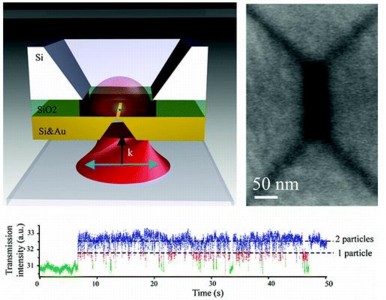Home > Press > New technique to detect and manipulate nano-objects using plasmonic nano-cavities
 |
| OpticalTrapping: SIBA plasmonic trapping using a Fabry–Pérot nanopore cavity |
Abstract:
Imec researchers have presented a new approach to detect and manipulate nano-objects. The technique makes use of plasmonic excitation in nanocavities. In a demonstration, a rectangular nanocavity was used to detect the presence of 22nm beads. This approach may open new routes to create optical tweezers at the nanoscale, for ultra-accurate sensing, trapping, and arranging of nanoscale objects, such as biomolecules (e.g. proteins or DNA).
New technique to detect and manipulate nano-objects using plasmonic nano-cavities
Leuven, Belgium | Posted on March 16th, 2012Optical trapping techniques, the so called optical tweezers, are used to trap and manipulate objects. A highly focused laser beam provides an attractive or repulsive force to physically hold and move microscopic dielectric objects (down to micrometer-scale). But this technique cannot be applied straightforward to nanoscale objects. The energy required to manipulate such small objects is simply too large in relation to their size and would destroy the objects. Recently, researchers have therefore come up with the idea to make use of the strong local fields of metal nanostructures that are excited by light.
When metal nanostructures are illuminated with visible to near-infrared light, strong local electromagnetic fields are generated. These are caused by the collective oscillations of conduction electrons - called surface plasmons. These fields can be detected and visualized e.g. through surface-enhanced Raman spectroscopy. And because the presence of nanosized objects, such as biomulecules, causes changes in the fields, this phenomenon can be used as a sensor.
But the energy of the local fields could also be used to trap and manipulate the nanosized objects. In a recent publication, imec's researchers now present a new approach that uses this technique. They combine self-induced back action (SIBA) trapping with the latest advances in nanoscale plasmon engineering.
As a demonstration, the researchers designed a resonant trap in the form of a rectangular nanopore. This form of pore allows for tuning the plamons by changing the aspect ratio. This trap was successfully tested with 22nm polystyrene beads, distinguishing between events where one bead was trapped, or those where two beads were trapped at the same time. As part of their work, the researchers also proposed a figure of merit to quantify the efficiency of their trapping mechanism and to compare it to other optical nanotweezers.
####
For more information, please click here
Contacts:
Barbara Kalkis
Maestro Marketing & PR
Copyright © IMEC
If you have a comment, please Contact us.Issuers of news releases, not 7th Wave, Inc. or Nanotechnology Now, are solely responsible for the accuracy of the content.
| Related Links |
![]() This work was published in the January edition of Nano-letters:
This work was published in the January edition of Nano-letters:
| Related News Press |
News and information
![]() Researchers develop molecular qubits that communicate at telecom frequencies October 3rd, 2025
Researchers develop molecular qubits that communicate at telecom frequencies October 3rd, 2025
![]() Next-generation quantum communication October 3rd, 2025
Next-generation quantum communication October 3rd, 2025
![]() "Nanoreactor" cage uses visible light for catalytic and ultra-selective cross-cycloadditions October 3rd, 2025
"Nanoreactor" cage uses visible light for catalytic and ultra-selective cross-cycloadditions October 3rd, 2025
Sensors
![]() Sensors innovations for smart lithium-based batteries: advancements, opportunities, and potential challenges August 8th, 2025
Sensors innovations for smart lithium-based batteries: advancements, opportunities, and potential challenges August 8th, 2025
![]() Quantum engineers ‘squeeze’ laser frequency combs to make more sensitive gas sensors January 17th, 2025
Quantum engineers ‘squeeze’ laser frequency combs to make more sensitive gas sensors January 17th, 2025
Discoveries
![]() Researchers develop molecular qubits that communicate at telecom frequencies October 3rd, 2025
Researchers develop molecular qubits that communicate at telecom frequencies October 3rd, 2025
![]() Next-generation quantum communication October 3rd, 2025
Next-generation quantum communication October 3rd, 2025
![]() "Nanoreactor" cage uses visible light for catalytic and ultra-selective cross-cycloadditions October 3rd, 2025
"Nanoreactor" cage uses visible light for catalytic and ultra-selective cross-cycloadditions October 3rd, 2025
Announcements
![]() Rice membrane extracts lithium from brines with greater speed, less waste October 3rd, 2025
Rice membrane extracts lithium from brines with greater speed, less waste October 3rd, 2025
![]() Researchers develop molecular qubits that communicate at telecom frequencies October 3rd, 2025
Researchers develop molecular qubits that communicate at telecom frequencies October 3rd, 2025
![]() Next-generation quantum communication October 3rd, 2025
Next-generation quantum communication October 3rd, 2025
![]() "Nanoreactor" cage uses visible light for catalytic and ultra-selective cross-cycloadditions October 3rd, 2025
"Nanoreactor" cage uses visible light for catalytic and ultra-selective cross-cycloadditions October 3rd, 2025
Tools
![]() Japan launches fully domestically produced quantum computer: Expo visitors to experience quantum computing firsthand August 8th, 2025
Japan launches fully domestically produced quantum computer: Expo visitors to experience quantum computing firsthand August 8th, 2025
![]() Rice researchers harness gravity to create low-cost device for rapid cell analysis February 28th, 2025
Rice researchers harness gravity to create low-cost device for rapid cell analysis February 28th, 2025
Alliances/Trade associations/Partnerships/Distributorships
![]() Chicago Quantum Exchange welcomes six new partners highlighting quantum technology solutions, from Chicago and beyond September 23rd, 2022
Chicago Quantum Exchange welcomes six new partners highlighting quantum technology solutions, from Chicago and beyond September 23rd, 2022
![]() University of Illinois Chicago joins Brookhaven Lab's Quantum Center June 10th, 2022
University of Illinois Chicago joins Brookhaven Lab's Quantum Center June 10th, 2022
|
|
||
|
|
||
| The latest news from around the world, FREE | ||
|
|
||
|
|
||
| Premium Products | ||
|
|
||
|
Only the news you want to read!
Learn More |
||
|
|
||
|
Full-service, expert consulting
Learn More |
||
|
|
||








